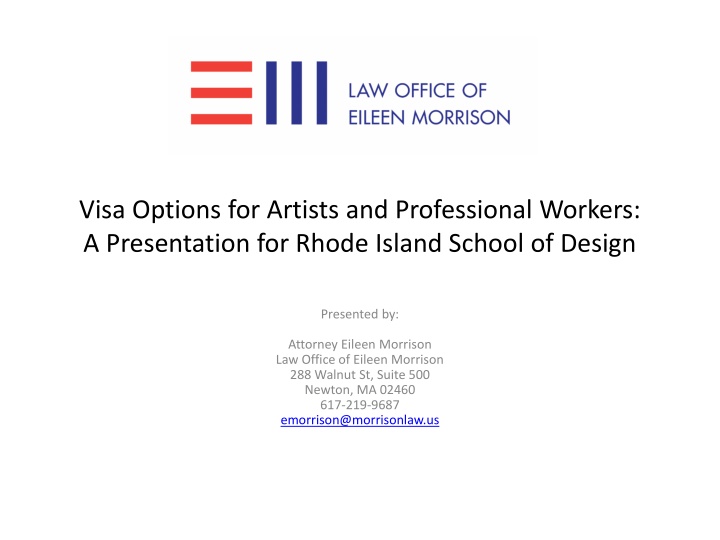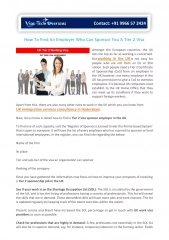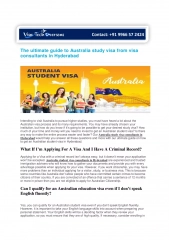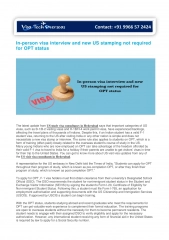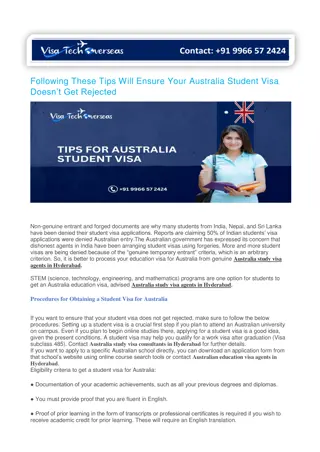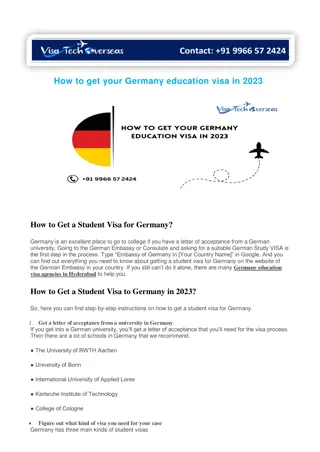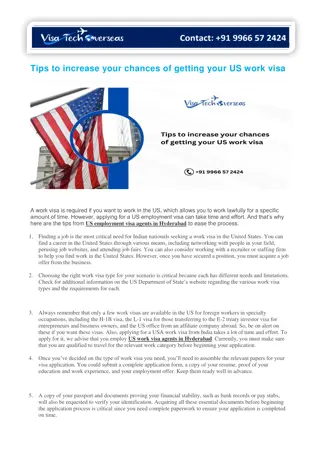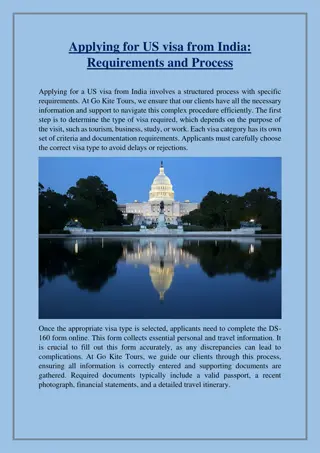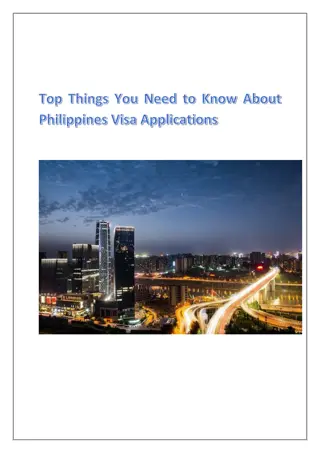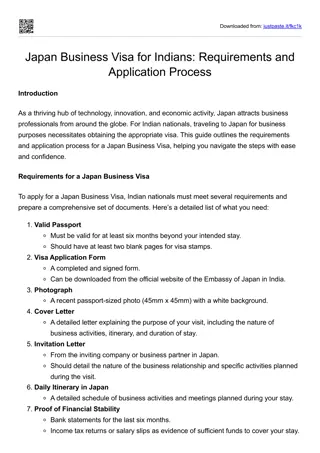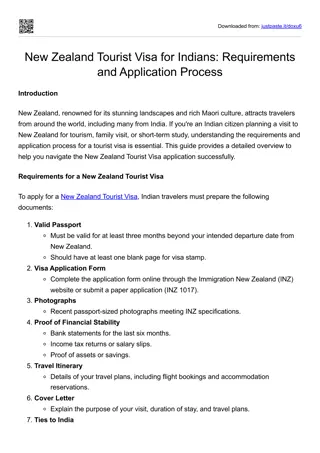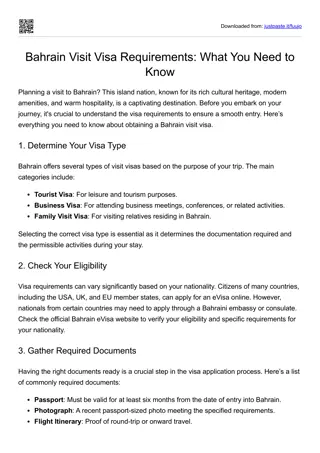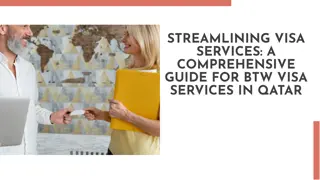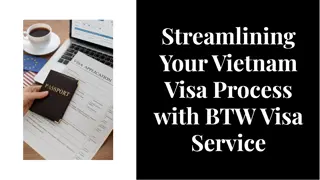Visa Options for Artists and Professional Workers
Presentation by Attorney Eileen Morrison on visa options post-academic training for artists and professional workers. Covers F-1 Optional Practical Training, J-1 Exchange Visitors, and H-1B/O-1 visa specifics for RISD graduates.
Download Presentation

Please find below an Image/Link to download the presentation.
The content on the website is provided AS IS for your information and personal use only. It may not be sold, licensed, or shared on other websites without obtaining consent from the author.If you encounter any issues during the download, it is possible that the publisher has removed the file from their server.
You are allowed to download the files provided on this website for personal or commercial use, subject to the condition that they are used lawfully. All files are the property of their respective owners.
The content on the website is provided AS IS for your information and personal use only. It may not be sold, licensed, or shared on other websites without obtaining consent from the author.
E N D
Presentation Transcript
Visa Options for Artists and Professional Workers: A Presentation for Rhode Island School of Design Presented by: Attorney Eileen Morrison Law Office of Eileen Morrison 288 Walnut St, Suite 500 Newton, MA 02460 617-219-9687 emorrison@morrisonlaw.us
F-1 Students Optional Practical Training Pre- and post-completion and CPT Up to 12 months per progressively higher degree but 24 months more possible for S.T.E.M. graduates
Lots to Love About OPT: It is very flexible You can quit a job you don t like, be self-employed or hold multiple jobs OPT students don t pay Social Security or Medicare tax May not accrue more than 90 days of unemployment on OPT
J-1 Exchange Visitors Academic training available for 18 months after completing a degree J-2 spouses may continue to apply to USCIS for employment authorization for the duration of the J-1 principal s status
Once I Finish Academic Training/OPT, What Visa Do I Need? Most commonly, RISD graduates seek either: 1. H-1B visa for professional occupations requiring a degree to do the job OR 2. O-1 visa for occupations in the arts, or film and television (also available in the sciences, business, education and athletics)
The H-1B Visa Employee must have a bachelor s degree (or equivalent) in the field that the job requires; and that the job requires the employee have at least a bachelor s degree in a specific field (or equivalent). Requires US employer to sponsor employee for full- or part-time work. Must have an employer/employee relationship and taxes must be withheld. No self-employment, freelance or contract work. Must have separate H-1B for each employer. 65,000 new visas available annually in this category for bachelor s degree (or equivalent). 20,000 more H-1B visas available to those with advanced degrees from U.S. educational institutions.
The H-1B Visa Cap-exempt H-1Bs (such as universities and certain research institutions). Full or part-time employment in H-1B is allowed. If the work is part-time, be prepared to explain how you are going to support yourself without resorting to unlawful employment. (Examples: spouse s earnings, savings, funds from abroad)
H-1B Cap-Subject Pre-registration Since 2020, pre-registration and pre-selection is required to apply for H-1B. FY 2024 pre- registration takes place between March 1-17, 2023. $10 fee. Notification of selection is immediately after selection for cases to be filed starting 04/01 to commence 10/1.
The LCA Before filing the H-1B petition, the employer must obtain a certified Labor Condition Application (LCA) from the DOL. The employer must certify that the employer is: Paying the prevailing wage or higher; The wages and working conditions of others at the place of employment will not be negatively impacted by employing the H-1B worker;
The Labor Condition Application Proper notice has been given at the place of employment or to the labor union if applicable; The employee has been provided with a copy of the certified, signed LCA; Strict punishment for employers willfully failing to meet a condition or for misrepresenting a material fact in the Labor Condition application.
Who Qualifies as a U.S. Employer? An employer is a person, firm, corporation, contractor, or other association, or organization in the United States which: (1) Engages a person to work within the United States; (2) Has an employer-employee relationship and may hire, pay, fire, supervise, and control the employee s work; (3) Has an Internal Revenue Service Tax Identification Number.
Will I Qualify for H-1B Status? The Beneficiary must at time of filing: (1) Have at least a US (or a foreign equivalent) bachelor's or higher degree from an accredited college or university or have completed all degree requirements; (2) Hold the required state license, registration or certification; (3) Can use a combination of education and experience.
Other H-1B Facts Return transportation costs: The employer is liable for the reasonable costs of return transportation of the employee to the last foreign residence abroad if the H-1B employee is terminated before the end of the period of authorized admission even for cause. Does not apply if the employee quits. Employee s spouse and unmarried children under 21: Dependent family members are granted H-4 status for as long as the H-1B employee is authorized to work here. They do not have their own employment authorization. They may, however, attend school or remain at home. Maximum stay in H-1B status: Six total years. Extension beyond six years possible if labor certification pending for at least one year. H-1B status granted in increments up to 3 years.
Legal/Filing Fees The employer must pay the H-1B legal fees and filing fees. Employees may pay for premium processing, since it is not a required filing fee. Premium processing provides a response from USCIS in 15 business days. PP not always available. PP fee is $2,500 in addition to the H-1B base filing fees.
Must I Use an Attorney? No, but it is really hard to figure out how to prepare a case correctly.
Supporting Evidence for an H-1B Petition The employer must submit with an H-1B petition: The certified LCA; A statement that it will comply with the terms of the labor condition application for the duration of the beneficiary's authorized period of stay;
Supporting Evidence for an H-1B Petition Copy of the Beneficiary s transcript and diploma or confirmation by the school of completion of all degree requirements; Copy of the Beneficiary s license to practice the profession (if applicable); Proof that the Beneficiary is in status (I-20, EAD, I-94, etc.);
O-1B Artists of Extraordinary Ability A US employer or agent may file a petition for an employee with extraordinary ability in the sciences, arts, education, business, athletics, or extraordinary achievement for someone in motion picture or television industry. Agents are helpful for people with lots of smaller jobs who are independent contractors. You could create a company while on OPT that could sponsor you but you can t sign your own paperwork. Single-member LLCs are possibly problematic. Need not be a job; can be independent contractor or a collection of projects. Guideline: No more than 45 days between activities. May file up to one year in advance of need.
Eligibility for O-1 The O-1 petition covers the event for which the O-1 beneficiary s services are needed: This means an activity such as, but not limited to, a project, conference, convention, lecture series, tour, exhibit, academic year, or engagement. May include short vacations, promotional appearances, and stopovers, incidental or related to the event. A group of related activities may also be considered to be an event. Granted in periods of up to 3 years.
Eligibility for O-1 The O-1 petition covers the event for which the O-1 employee s services are needed: This means an activity such as, but not limited to, a scientific project, conference, convention, lecture series, tour, exhibit, business project, academic year, or engagement. May include short vacations, promotional appearances, and stopovers, incidental or related to the event. A group of related activities may also be considered to be an event. Granted in periods of up to 3 years- petitioner s contract/agreement controls.
Extraordinary ability, defined Extraordinary ability in the field of arts means distinction. Distinction = a high level of achievement in the field of arts evidenced by a degree of skill and recognition substantially above that ordinarily encountered to the extent that a person described as prominent is renowned, leading, or well-known in the field of arts.
Extraordinary ability, defined What does extraordinary ability in the field of science, education, business, or athletics mean? This standard is defined as a level of expertise indicating that the person is one of the small percentage who have arisen to the very top of the field of endeavor. Whenever you can, you want to make the field arts .
Extraordinary Ability, Defined What does extraordinary achievement in the field of motion picture and television productions mean? This standard means a very high level of accomplishment in the motion picture or television industry evidenced by a degree of skill and recognition significantly above that ordinarily encountered to the extent that the person is recognized as outstanding, notable, or leading in the motion picture or television field.
What Fields in the Arts are Covered? Any creative field including fine arts, visual arts, culinary arts, and performing arts. Principal creatives & essential persons such as, but not limited to, directors, set designers, lighting designers, sound designers, choreographers, choreologists, conductors, orchestrators, coaches, arrangers, musical supervisors, costume designers, makeup artists, flight masters, stage technicians, and animal trainers.
Evidentiary Standard For O-1B To qualify as an beneficiary of extraordinary ability in the field of arts, the beneficiary must be recognized as being prominent in his or her field as demonstrated by: (A) Evidence that the beneficiary has been nominated for, or won, significant national or international awards or prizes in the particular field (Academy Award, Emmy, Grammy, etc.); or
At Least 3 of the Following: (1) Evidence that the beneficiary has performed, and will perform, services as a lead or starring participant in productions or events which have a distinguished reputation (critical reviews, advertisements, publicity releases, publications contracts, or endorsements); (2) Evidence that the beneficiary achieved national or international recognition for achievements shown by critical reviews or other published materials by or about the individual in major newspapers, trade journals, magazines, or other publications; (3) Evidence that the beneficiary has performed, and will perform, in a lead, starring, or critical role for organizations and establishments that have a distinguished reputation shown by articles in newspapers, trade journals, publications, or testimonials;
At Least 3 of the Following: (4) Evidence that the beneficiary has a record of major commercial or critically acclaimed successes as evidenced by such indicators as title, rating, standing in the field, box office receipts, motion picture or television ratings, and other occupational achievements reported in trade journals, major newspapers, or other publications; (5) Evidence that the beneficiary has received significant recognition for achievements from organizations, critics, government agencies, or other recognized experts in the field in which the beneficiary is engaged (good place for lesser awards like residencies (i.e., Fine Arts Work Center, Skowhegan, etc.); or (6) Evidence that the beneficiary has either commanded a high salary or will command a high salary or other substantial remuneration for services in relation to others in the field (contracts or other reliable evidence); or
At Least 3 of the Following , continued: Other comparable evidence of the beneficiary s eligibility this presents great opportunities for creativity to show what makes your work so great.
Evidentiary Criteria for O-1 Visa in the Arts Define the field as narrowly as possible. Think big fish, small pond. Example: Graphic Designer vs. Video Game Graphic Designer
Consulting Organization/Union Opinion O-1s require a labor union (if there is one in the occupation) or a consulting organization opinion. Costs typically $250-$550. Film requires a management organization consult on top of that. File with the O-1 whenever possible.
Evidentiary Criteria for Extraordinary Ability in Motion Pictures/Television (A) Evidence that the beneficiary has been nominated for, or has been the recipient of, major national or international awards (i.e., an Academy Award, an Emmy, a Grammy); or (B) At least three of the following: (1) Evidence that the beneficiary has performed, and will perform, services as a lead or starring participant in productions or events which have a distinguished reputation (critical reviews, advertisements, publicity releases, publications contracts, or endorsements); (2) Evidence that the beneficiary has achieved national or international recognition for achievements (critical reviews or other published materials by or about the individual in major newspapers, trade journals, magazines, or other publications); (3) Evidence that the beneficiary has performed, and will perform, in a lead, starring, or critical role for organizations and establishments that have a distinguished reputation (articles in newspapers, trade journals, publications, or testimonials);
Evidentiary Criteria for O-1 in Motion Pictures/Television (4) Evidence that the beneficiary has a record of major commercial or critically acclaimed successes (title, rating, standing in the field, box office receipts, motion picture or television ratings, and other occupational achievements reported in trade journals, major newspapers, or other publications). (5) Evidence that the beneficiary has received significant recognition for achievements from organizations, critics, government agencies, or other recognized experts in the field in which the beneficiary is engaged. (6) Evidence that the beneficiary has either commanded a high salary or will command a high salary or other substantial remuneration for services in relation to others in the field, as evidenced by contracts or other reliable evidence.
Evidentiary Criteria for O-1 in Motion Pictures/Television No opportunity to submit other comparable evidence in this category. Must submit consultation opinions from 2 consulting organizations (i.e., IATSE and AMPTP for a film editing job).
Items of Interest How long is the O-1 petition valid? Up to 3 years, with extensions granted in one year increments for same employer for same activity. No upper limit on O-1 stay. Can a spouse and unmarried children under 21 come with the O-1 employee? Yes. The spouse and children may remain in the US as long as the O-1 employee is authorized to work here. They do not have their own employment authorization. They may attend school or remain at home.
Comparison of O-1B and H-1B O-1B for the Arts Granted for up to 3 years initially No upper limit on stay No degree required No PW Employer or employee may pay lawyer and filing fees No limit on visa #s Need consulting org opinion H-1B Professional Work Visa Granted for up to 3 years initially Max. stay of 6 years (some extensions possible if LPR process started timely. Degree related to job required Employer must pay lawyer and filing fees Limited to 65,000 + 20,000 for US masters degree grads
Comparison of O-1B and H-1B O-1B Visa in the Arts Can include additional engagements with other employers without amending, if gigs require an artist of extraordinary ability Can have an ownership interest in the company, but must disclose it. H-1B Professional Work Visa No self-employment One H-1B for each company seeking to hire the Beneficiary
Additional Visa Possibilities There are some other professional work visas specific to the beneficiary s nationality. TN-1 for Canadians and Mexicans restricted to TN occupations (includes college teacher, architect, industrial designer, interior designer, graphic designer). Specific minimum requirements are specified in the Free Trade agreement.
TN-1 No self-employment allowed No upper limit on stay-may be a practical limit Approvable for up to 3 years at a time Spouses and children are admitted in TD status and are not permitted to work Immigrant intent not allowed
Other Visa Possibilities: E-3 for Australians (like an H-1B but valid for 2 years at a time) H-1Bs for nationals of Singapore or Chile (special quotas) E-2 visas for investors from specific countries Investment varies depending on the business Investor must be coming to develop and direct an active investment Could be the employee of an E-2 company with same nationality as the E-2 company
Whats Next? How long does the beneficiary want to stay in the U.S? a. A few years stay on the NIV b. Permanently need permanent residence
Permanent Residence Permanent residence, aka green card status: The unlimited right to live and work in the U.S.
Paths to Permanent Residence 1. Family-based 2. Employment-based
Family-Based Categories: Marrying a U.S. citizen allows one to apply immediately for permanent residence. Unlimited numbers of visas are available annually. Cases are interviewed in the local district office. Marrying a U.S. permanent resident allows one to apply for classification as a spouse of a U.S. permanent resident, but not for an actual green card until the priority date is current. Limited number available annually. As of March 2023, they are current.
Other Family-Based Categories: Unmarried sons and daughters of U.S. citizens (F-1) Married sons and daughters of U.S. citizens (F-3) Brothers or sisters of adult U.S. citizens (F-4) These categories have long waiting lines-up to 22+ years. The longer queues for high-immigration countries (India, Mexico, the Philippines, China).
Employment-Based First Preference: Evidence: EB-1 evidence is similar but not identical to the O-1B category. Allows for self-sponsorship without an actual job offer. Must show there are people or organizations who would hire you in the future.
EB-1 Extraordinary ability: a level of expertise indicating that the individual is one of that small percentage who have risen to the very top of the field. The beneficiary must have sustained national or international acclaim and show that his or her achievements have been recognized in the field.
EB-1 Evidence Evidence: Either a major internationally recognized award (Nobel Prize, Emmy, Grammy, etc.) OR at least 3 of the following: 1. Proof of the beneficiary s receipt of lesser nationally/internationally recognized prizes/awards for excellence in the field;
EB-1 criteria, continued 2. Documentation of the beneficiary s membership in associations in the field for which classification is sought, which require outstanding achievements of their members, as judged by recognized national or international experts in their disciplines or fields (ex: AAAS); 3. Published material about the beneficiary in professional or major trade publications or other major media, relating to the beneficiary s work in the field for which classification is sought (including the title, date and author of the material, and translation); 4. Evidence of the beneficiary s participation, either individually or on a panel, as a judge of the work of others in the same or an allied field of specialization for which classification is sought;
EB-1 criteria, continued. 5. Evidence of the beneficiary s original scientific, scholarly, artistic, athletic or business-related contributions of major significance in the field; 6. Evidence of the beneficiary s authorship of scholarly articles in the field, in professional or major trade publications or other major media; 7. Evidence of the display of the beneficiary s work in the field at artistic exhibitions or showcases (visual arts);
EB-1 criteria, continued. 8. Evidence that the beneficiary has performed in a leading or critical role for organizations or establishments that have a distinguished reputation; 9. Evidence that the beneficiary has commanded a high salary or other significantly high remuneration for services, in relation to others in the field; or 10. Evidence of commercial successes in the performing arts, as shown by box office receipts or records, cassette, CD, or video sales;
